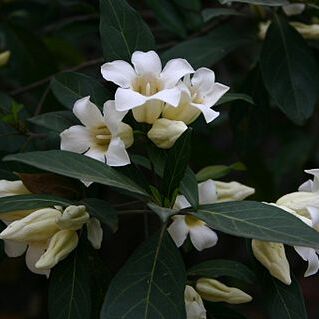A small tree. It grows 4-7 m high but can be 15 m high. Leaves are shiny. They are simple and opposite. They are 3.8-10 cm long. They are often sword shaped. The base is narrow. The leaves are dark green above and paler underneath. It has bell-shaped flowers. These occur singly or in clusters on short side branches. The flowers are 3.8 cm across. They are white and can have pink marks. They have a sweet scent. The fruit are round and 1.9-2.5 cm across. The shell is soft and corky but becomes hard later. The seeds are flat and imbedded in the pulp. The fruit are edible.
Slender, evergreen (briefly deciduous), small tree, 2-8 m high. Leaves opposite, lanceolate to elliptic, dark green above, paler below, venation pinkish, prominent below; hair-tuft domatia below; petioles ± 7 mm long. Calyx with cylindrical tube; lobes fused to ± halfway, free ends membranous, apices linear, erect. Corolla 5-lobed, showy, campanulate, cream-coloured with pink honeyguides. Stamens 5, included. Flowering time Aug.-Nov. Fruit globose, brown, hard and woody when dry, crowned with persistent calyx.
Small tree or shrub, up to 8 m high. Flowers up to 10 cm fascicles. Corolla tube 20-35 mm long, cylindrical part scarcely extending beyond calyx limb, campanulate above. Flowers white to cream with dark spots in throat.


